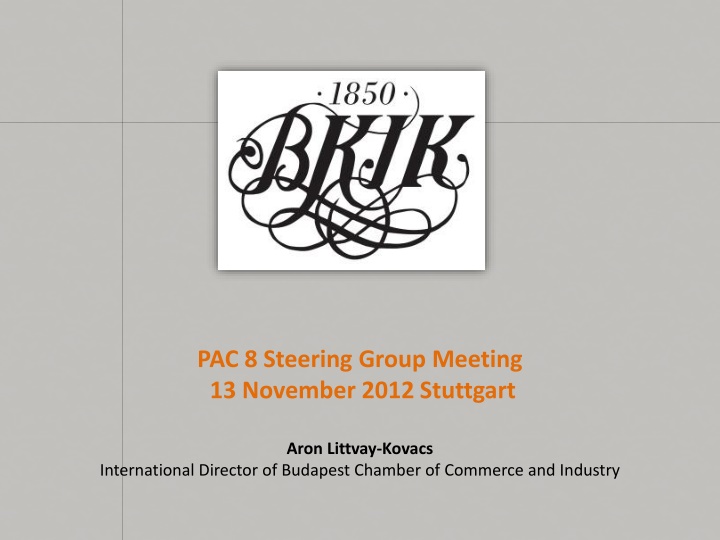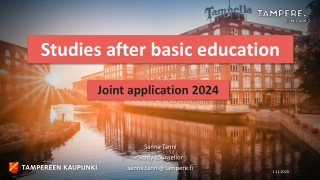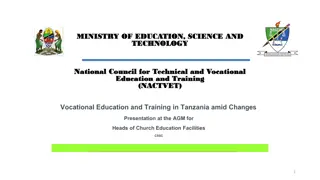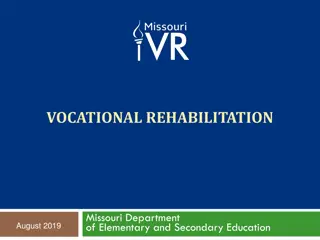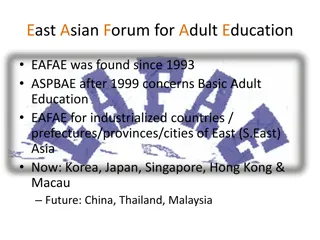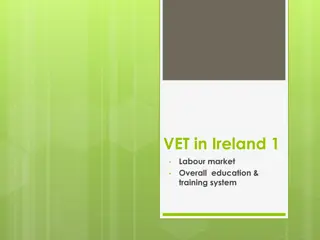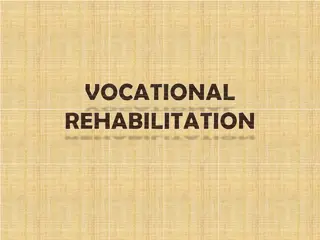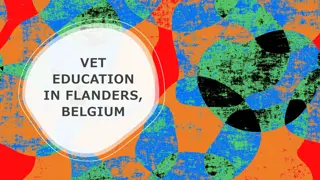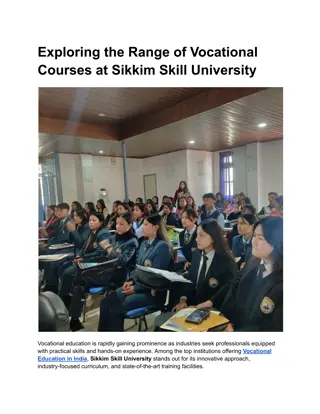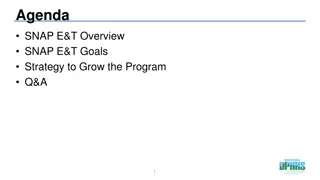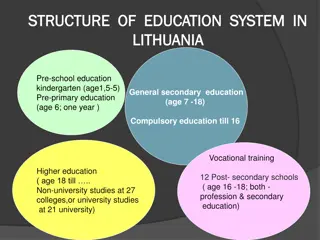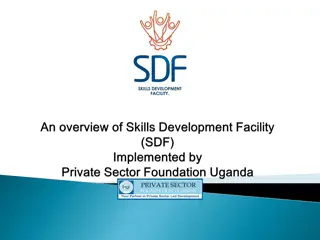Vocational Education and Training System Development Project
This project aims to reform the Hungarian VET system through collaboration with relevant institutions, creating a VET cluster, and examining effective models for specific professions. The initiative involves input from chambers, enterprises, and education institutions to enhance vocational training in the region.
Download Presentation

Please find below an Image/Link to download the presentation.
The content on the website is provided AS IS for your information and personal use only. It may not be sold, licensed, or shared on other websites without obtaining consent from the author.If you encounter any issues during the download, it is possible that the publisher has removed the file from their server.
You are allowed to download the files provided on this website for personal or commercial use, subject to the condition that they are used lawfully. All files are the property of their respective owners.
The content on the website is provided AS IS for your information and personal use only. It may not be sold, licensed, or shared on other websites without obtaining consent from the author.
E N D
Presentation Transcript
PAC 8 Steering Group Meeting 13 November 2012 Stuttgart Aron Littvay-Kovacs International Director of Budapest Chamber of Commerce and Industry
Action: Vocational Education and Training System in the Region s Member States .
The VET project idea The project idea came from the market especially, labour market as well as German automotive companies who have setteled in Hungary First project disscussion was held in Ulm, in March 2011. This meeting was followed by Conference in Budapest in June, 2011. The Mercedes company together with Chamber of Economics created 5 more professions at the National Profession Register in the end of June 2011. That would continue this project /Meeting in Stuttgart in July 2012/ The result of SEE program: VET project did not accepted at the SEE
Milestone n1/A: Institutional partnership building Estabilishing contacts with relevant institutions and initiatives Work: Macro-region education institutions and goverment institutions has to be involved Output: The mentined institutions could provide that these projects could wide-known Responsable: SG country members
Milestone n1/B: Establishing a VET cluster with the involvement of chambers, major enterprises, and academic and vocational education institutions in the region Work: preparation of organization rules and organizing stakeholder and contributors. Public Administration institutions, employer organisations as well as employee organisations should be involved from the member countries which are interested in vocational education and training system. Output: creating cluster Responsible: DCCA members; Deadline: 31.12.2012.
Milestone n2: Examining which model (dual or school) is more effective for specific groups of professions. Work: analysing of the models. These models could be country- specific. National characteristics has to be taken into account and consultations among the participating members are needed continuously. Output: list of qualifications Responsible: Expert Working Groups; Deadline: 31.03.2012.
Milestone n3: Reforming the Hungarian VET system in the framework of a PILOT project Work: The German and Austrian chambers will provide the know-how Other participants will monitor as well as give professional advice and prepare for the utilization of experience Reviewing and streamlining the National Register of Qualifications and aligning it with other systems in the region Revising some of the qualifications in line with the labour market demand Simplifying the examination system, making those competencies already acquired contribute to it Establishing and operating independent examination centres Improving the VET programmes based on the experience obtained Establishing an effective career orientation and follow-up system that also relies on labour market forecasts Sharing experience with other countries in the region Output: 1. Independent Test Centre 2. Best Practices Responsible: Budapest Chamber of Commerce and Industry and the relevant partners; Deadline: 01.08.2013
Milestone n4: Adapting the findings of the Hungarian PILOT project to other countries of the region, taking into account the national characteristics and with a view to facilitating the free flow of capital and workforce Work: Adaptation. The Austrian and German partners will hold the supervisor post and the Hungarian chamber will hold the operative post. The Hungarian experience need to utilize in the countries of the Region. Output: Effective Vocational Training System Responsible: Chamber of Commerce of partner countries; Deadline: 31.12.2013.
Milestone n5: Improving the prestige of skilled work Work: Public procurement to find constructors and supervisors to develop the ports. Output: Promote the Results. The Region wide media campaign as well as local road shows required which will focus on the results. Responsible: DCCA members and the relevant partners; Deadline: 31.12.2013.
Benefits of this project: Benefefits from German and Austrian Vocational Education model would create high competitiveness for companies, employers and eployees in the whole Danube Region. It would create competitive education system as well.
EUSDR EUSDR projectproposals projectproposals of supported supported by of the the BCCI, the DCCA DCCA BCCI, by the Introducing dual vocational training system in the South East Europe integration of the different vocational training systems, establishing a Vocational Training Cluster The project is based on following questions: How far is vocational training in accordance with market requirements? How similar is the expertise acquired in different countries of the region? What is the reason for skills shortages in more and more sectors and how could be stopped this gap?
General goals: Spread of uniform vocational education in South East Europe; Professionals educated and trained in accordance with the needs of the labour market of the Danube Region countries; The creation of a uniform training system whose certificate all countries accept; The interoperability between countries can happen due to same professional qualifications to develop an integrated vocational training system that allows countries to recognize each other s certificates and applies a uniform system of requirements to reach the equivalent knowledge level at each profession in the region. to enhance the role of environmental protection and an environmentally conscious approach in the vocational training programmes
Specific goals: 1. The promotion of uniform vocational education in national media by all project partners (WP2); 2. Founding the institution of the EGTC that will later apply for registration (WP3); 3. The study of the experiences and results of the German and Austrian educational systems, in order to implement them to the future training system (WP4); 4. Increasing the interest and willingness of economic entities in practical training and the preparation of a Pilot in Hungary (WP5); 5. Design of registration system in Hungary in order to record the capacity of the future training centres (WP5); 6. Increasing the interest and willingness of economic entities in practical training in Slovenia, Romania, Serbia and Croatia (WP6)
Background Vocational tarining is not only an education policy but an employment policy, an economic policy and social policy, Creation of work based society and development of harmonised education system is a strategic goal in the region, its basic tool is the development of a harmonised education system
Challange The greatest obstacle of free flow of labour and thereby catching up of the region is that there is no uniform vocational training The national training systems of individual countries are different both in terms of content and standard of training. This also hampers regional SMEs mobility through national borders.
Our project Dual vocational training in the region coordination of training systems, vocational clusters connects the following action of EUSDR: Action - To support enterprises through high performing training and qualification schemes . The shortage of skilled workers and the high unemployment of unskilled workers in the Region has implications competitiveness of enterprises and can be addressed by improving the qualification schemes in the Danube countries thus raising the overall qualification levels and opportunities of the labour force. Through closer cooperation of relevant labour market institutions and chambers of commerce, existing best practices could be exchanged thus supporting Framework". Support instruments should be developed for enterprises engaged in increasing the capacity and productivity of their workforce. Full use should be made of existing institutions and bodies in the Region. on the the "European Qualifications
Example of project - To develop joint programmes for professional education and vocational training together with enterprises with the aim to improve the efficiency of training and qualification programmes in the Region. This could bring together the private sector, public administration in the fields of education and labour market, and civil society such as chambers of commerce to develop and coordinate professional and language training programmes, coordinate curricula and exchange of guest lecturers and students. Furthermore the need for new pilot training centres should be analysed. The creation of a centre for professional education in the electro-technical industry in Bratislava is proposed as an example. (Lead: Slovakia; Danube Chambers of Commerce Association).
WORK PACKAGES: WP1, Project management and coordination; WP2, Communication, knowledge management and dissemination; WP3, Institutional development; WP4, Analysis and evaluation; WP5, Preparation of Pilot in Hungary; WP6, Preparation of extension in Slovenia, Romania, Serbia and Croatia.
EXPECTED RESULTS OF THE INITIATIVE: As a result of the future vocational centres, graduate students will take on jobs easier, companies will find the right labour force easier, thereby, the competitiveness of companies will rise in South East Europe Skilled workers with knowledge of identical level would leave schools, as a result of which moving companies across borders would become easier since it would be clear to enterprises what knowledge and competencies labour has in a given country. The future uniformly trained workforce will allow SSE enterprises to save money and time at home and abroad, too. SEE enterprises will have more resources released and, as a consequence, their innovation potential will be unleashed. The structure of vocational training, the number and preparedness of issued students will be able to adjust better and more flexibly to the needs of the economy. Local small and medium-sized companies will have greater chances for co- operating as suppliers with multinational companies; so, employment can significantly grow. Based on the so evolving macro-regional knowledge and competence basis, inflow of investor capital would grow.
PARTNERSHIP: A regional cooperation of chambers, like the Danube Chambers and Commerce Association (DCCA), is a perfect, already existing partnership that can address the problem of the disintegrated national vocational educational systems in Central Europe. Members of the DCCA have developed the idea of a united Vocational Training Cluster, and the present project is the first step in its realization in South East Europe. Budapest Chamber of Commerce and Industry (HU1) as ERDF Lead Partner Vienna Economic Chamber (AT) as ERDF Project Partner Chamber of Commerce and Industry of Slovenia, Institute for Business Education (SLO) as ERDF Project Partner Croatian Chamber of Economy, Osijek County Chamber (HR) as IPA Project Partner Belgrade Chamber of Commerce (RS) as IPA Project Partner Bucharest Chamber of Commerce and Industry (RO1) as ERDF Project Partner Timisoara Chamber of Commerce and Industry (RO2) as ERDF Project Partner Chamber of Commerce and Industry of Gy r-Moson-Sopron County (HU2) as ERDF Project Partner Chamber of Commerce and Industry of P cs-Baranya County (HU3) as ERDF Project Partner.
TARGET GROUPS: Primary school graduates in the participating countries Primary school graduates in Hungary, Slovenia, Romania, Serbia and Croatia are the potential students and thus the primary target group of the future uniform dual vocational education system of SEE. Their attention need to be drawn to the main characteristics of, and the list of opportunities a regional uniform vocational education system can provide them. Their involvement in the project is mainly targeted recipients . Parents of primary school graduates from the participating countries Member companies of the participating chambers (project partners): SME members of the participating chambers make up a large number of potential companies who could actively participate locally in the uniformed vocational educational system by providing an opportunity of practical training at their workplaces for the students. Decision makers dealing with the legal background of national education in the participating countries In Hungary dual vocational education needs to be reformed and matched to the planed uniform vocational education system of SEE. In Slovenia, Romania, Serbia and Croatia no dual vocational education exists, so here especially the legal background needs to be correlated to the planed initiative.
Thank you for your attention! Kovacs.aron@bkik.hu www.bkik.hu office@danubechambers.eu www.danubechambers.eu
